Since an emperor cannot be present to all persons, it is necessary to set up the statue of the emperor in law courts, market places, public assemblies, and theatres. In every place, in fact in which an official acts, the imperial effigy must be present, so that the emperor may thus confirm what takes place. For the emperor is only a human being, and he cannot be present everywhere. (Severian of Gabala, On the Creation of the World 5.5, as qtd. in J. Elsner, Imperial Rome and Christian Triumph, p. 54)
The image of the emperor is also called the emperor, yet there are not two emperors. Power is not divided nor is glory separated. Just as he who rules us is one power, so the homage he receives from us is one, not multiple, for the honour given to the image is transferred to the prototype. ( St. Basil (AD 330-379, quoted in J. Elsner, Imperial Rome and Christian Triumph, p. 57)
An important theme in Medieval art is the continuity of the Roman Empire. As we will see the Byzantine Empire of Justinian and the Carolingian Empire of Charlemagne traced their origins back to the Roman Empire of Augustus and his followers. But just as continuity is an important theme, so is transformation. The institution of imperial authority underwent dramatic changes during the period of Late Antiquity. The idea of the Emperor as the Principate or the first citizen of Rome gave way to the idea of the Emperor as the Dominate or as the absolute and awesome wielder of power. This transformation in the conception of imperial power is dramatically manifested in imperial images. As testified to by the quotation above, images of the Emperor held great power in the Roman World. Ernst Kitzinger has written that art became Medieval before it became Christian. By this he means that there was already a move away from the naturalistic and organic style of the Classical tradition to a more abstract and mechanical style independent of the influence of Christianity.
Jás Elsner in his recent book Imperial Rome and Christian Triumph, has written: "Power is very rarely limited to the pure exercise of brute force.... [T]he Roman state bolstered its authority and legitimacy with the trappings of ceremonial --cloaking the actualities of power beneath a display of wealth, the sanction of tradition, and the spectacle of insuperable resources....Power is a far more complex and mysterious quality than any apparently simple manifestation of it would appear. It is as much a matter of impression, of theatre, of persuading those over whom authority is wielded to collude in their subjugation. Insofar as power is a matter of presentation, its cultural currency in antiquity (and still today) was the creation, manipulation, and display of images. In the propagation of the imperial office, at any rate, art was power.
The direct association of art and imperial power Elsner discusses above, provides an important context to consider the comparison between the following images. As your first journal assignment compare the two images below. In your comparison discuss how these images convey power:
Both of these statues can be identified as cuirass statues, referring to the military breastplate worn by the figures. This formula documents the military function of the Emperor as the leader of the army. The upraised arms of both figures can be related to the so-called ad locutio gesture that traditionally conveyed the power of speech in Roman art. Both of these images were intended to give visual demonstration of the emperor's power. Scholars have noted that the change in styles evident in this comparison can be associated in a significant reformulation of the theory of imperial power that occurred in the period between these two works. Augustus saw himself as the Principate of Rome. By this he meant that he considered himself the first citizen of Rome or the first among equals. By the end of the third century A.D. the Emperor was considered to be the Dominate. This asserts the absolute and divine authority of the Emperor. This shift in conception of the Imperial nature is reflected in laudatory descriptions of the Emperor or what are are called panegyrics. Read the texts included on the page entitled Imperial Panegyrics and relate them to the comparison above. In your journal entry discuss how these two images make you feel and your sense of relationship to them.
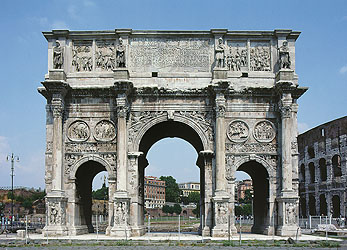
A monument documenting this shift in conception of Imperial power is represented by the Triumphal Arch built by the Senate to commemorate Constantine's defeat of his rival Maxentius at the Battle of the Milvian Bridge in 312 A.D. It is hard to overstateu the importance of Constantine in the narrative of Medieval art. His patronage and ultimate conversion to Christianity were pivotal in the transformation of Christianity as a religion on the margins to Christianity as integral to imperial power. An important theme we will be developing in the first part of this course is the Christianization of Rome and the Romanization of Christianity. It is interesting to note that on the Arch that was constructed adajacent to the Colosseum, near the formal center of old Rome, there are no references to Christianity. There is not even a reference to the famous vision of the monogram of Christ that Constantine was believed to have seen before the Battle of the Milvian Bridge. It is important to see how this monument justifies Constantine's power by linking him to the Roman Imperial past. In its form as a Triumphal Arch it links Constantine to the tradition of this form going back to monuments like the Arch of Titus constructed after 81 A.D.:

Significantly it was decided to include on the Arch of Constantine reliefs that were taken from monuments made for earlier Emperors. There is a relief in the passageway under the primary arch that is from the time of the Emperor Trajan, while the roundels or medallions were made for the Emperor Hadrian. The oblong reliefs in the attic come from the time of the Emperor Marcus Aurelius. Scholars used to argue that this use of "spolia" from earlier buildings was a good indication of artistic decline. More recently scholars have seen this inclusion of earlier monuments as a way of linking Constantine to the great emperors of the past.
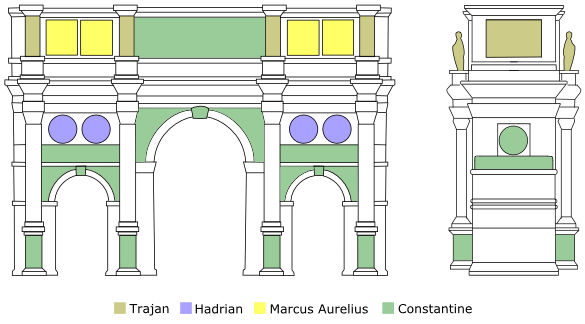
Despite this clear linking of Constantine to the Roman Imperial past, one can not help but be struck by the dramatic constrast in style between the earlier reliefs and the Constantinian reliefs:
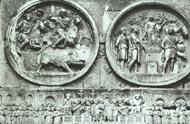
The medallions depict on the left Hadrian hunting and on the right Hadrian sacrificing at an altar dedicated to the god Apollo. The relief below shows in the center the beheaded figure of Constantine making an oration for the Rostrum in Rome:

This connection between Constantine and Rome's past glory is also found in the Constantinian reliefs. For example, one of the principal Constantinian reliefs shows Constantine making an oration as part of the triumphal celebration after his defeat of Maxentius. The oration is set at the Rostra in the Roman Forum, the central public meeting place in Rome. 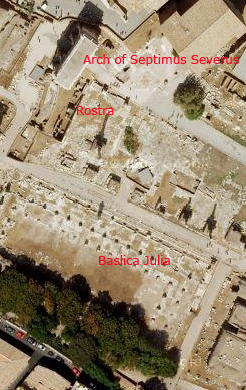 The arches on the right undoubtedly refer to the Arch of Septimius Severus while the structure on the left probably represents the Basilica Julia, begun by Julius Caesar in 46 Bce and completed by Augustus. The now beheaded figure of Constantine is shown in the center of the relief making the ad locutio gesture and wearing military dress. The origin of the office of imperator was as military commander. Constantine's dress and gesture thus define him as the voice of imperial authority. He is surrounded by frontal figures dressed in togas, the traditional dress associated with members of the senatorial class. At either end of the Rostra appear two seated figures elevated above the other figures. These seated figures are identifiable as sculptural portraits of Hadrian and Marcus Aurelius. The three highest figures in the relief are, thus, Constantine (had his head survived) and the two second century predecessors. The five columns behind the Rostra make a reference to the link between Constantine and his immediate predecessor Diocletian. In 303 A.D. a monument commemorating the tenth year of Diocletian's rule was constructed at the Rostra. The monument was composed of five columns with the central one topped by an image of Jupiter, flanked by others topped by images of the four Tetrarchs. This relief thus places Constantine at the center of Rome both physically, socially, and historically.
The arches on the right undoubtedly refer to the Arch of Septimius Severus while the structure on the left probably represents the Basilica Julia, begun by Julius Caesar in 46 Bce and completed by Augustus. The now beheaded figure of Constantine is shown in the center of the relief making the ad locutio gesture and wearing military dress. The origin of the office of imperator was as military commander. Constantine's dress and gesture thus define him as the voice of imperial authority. He is surrounded by frontal figures dressed in togas, the traditional dress associated with members of the senatorial class. At either end of the Rostra appear two seated figures elevated above the other figures. These seated figures are identifiable as sculptural portraits of Hadrian and Marcus Aurelius. The three highest figures in the relief are, thus, Constantine (had his head survived) and the two second century predecessors. The five columns behind the Rostra make a reference to the link between Constantine and his immediate predecessor Diocletian. In 303 A.D. a monument commemorating the tenth year of Diocletian's rule was constructed at the Rostra. The monument was composed of five columns with the central one topped by an image of Jupiter, flanked by others topped by images of the four Tetrarchs. This relief thus places Constantine at the center of Rome both physically, socially, and historically.
In your journal, compare the styles of these two reliefs.
On another face of the Arch we see medallions representing Hadrian participating in a Lion Hunt and him sacrificing juxtaposed to a frieze representing the largesse of Constantine:
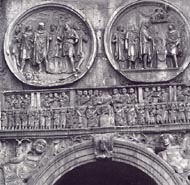
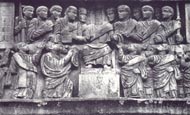
The image of Constantine's largesse reflects another standard formula of Roman Imperial Iconography. One of the attic reliefs from the time of Marcus Aurelius represents the "liberalitas" or largesse of this second century emperor:
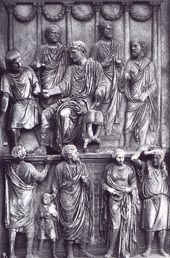
Significantly the head of Marcus Aurelius in this relief has been recut to represent Constantine. As exemplified by this head from one of the Hadrianic Medallions, other heads of the second century reliefs were recarved to represent Constantine:
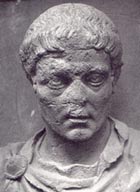
The carving of this head demonstrates the point that there were still sculptors available at the time of Constantine who were capable of working in the Classical style.
Imperial images ranged from monumental works like the over 8' head of Constantine that was part of a colossal statue of him in his Basilica in Rome:
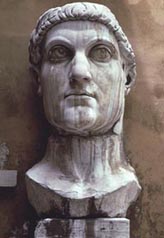
To imperial images on Roman coinage:
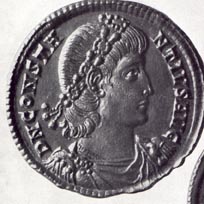
|
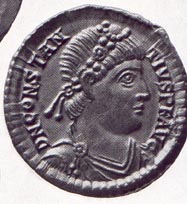
|
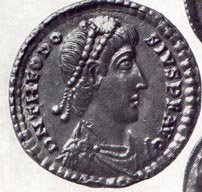 |
What do you make of the comparison of these different images? Compare these heads to that of the Colossus of Barletta. Write your responses in your journal.
A significant innovation / renovation in the portraiture of Constantine is the decision to represent himself beardless. From the second century emperors like Hadrian, it had been a regular convention to represent the emperor with a beard. This was apparently to relate the Emperor to conventions of representations of Greek Philosophers. The beardless type consciously adopted by Constantine links him back to the beardless formula adopted by Augustus and his successors (see the Augustus of Primaporta above). It thus signifies a break from the immediate past and a link to the foundation of Imperial rule with Augustus. The adoption of this formula by his successors was a way of establishing a dynastic link to Constantine as the new Augustus. It is significant that Julian the Apostate (reigned 361-3) who was the only pagan fourth century emperor revived the bearded type.
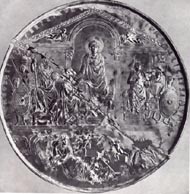


This silver plate was produced to commemorate in January 388 the decennalia or tenth anniversary of Theodosius's accession to the Imperial Office. In your journal present your "reading" of the symbolism of this work.